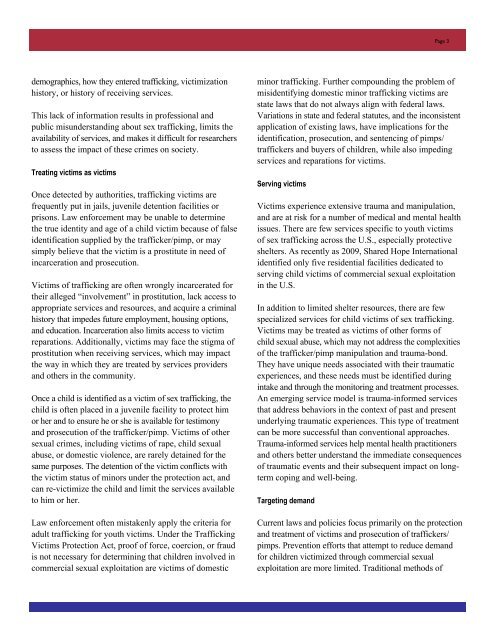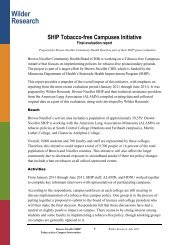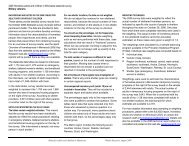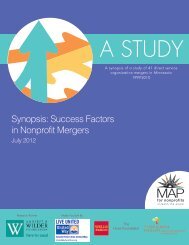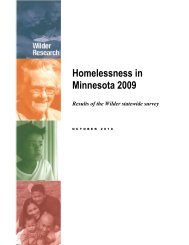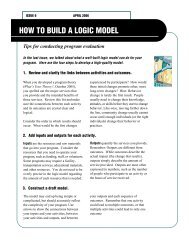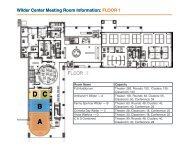Overview of Domestic Trafficking of Minors in the United States ...
Overview of Domestic Trafficking of Minors in the United States ...
Overview of Domestic Trafficking of Minors in the United States ...
Create successful ePaper yourself
Turn your PDF publications into a flip-book with our unique Google optimized e-Paper software.
Page 3demographics, how <strong>the</strong>y entered traffick<strong>in</strong>g, victimizationhistory, or history <strong>of</strong> receiv<strong>in</strong>g services.This lack <strong>of</strong> <strong>in</strong>formation results <strong>in</strong> pr<strong>of</strong>essional andpublic misunderstand<strong>in</strong>g about sex traffick<strong>in</strong>g, limits <strong>the</strong>availability <strong>of</strong> services, and makes it difficult for researchersto assess <strong>the</strong> impact <strong>of</strong> <strong>the</strong>se crimes on society.Treat<strong>in</strong>g victims as victimsOnce detected by authorities, traffick<strong>in</strong>g victims arefrequently put <strong>in</strong> jails, juvenile detention facilities orprisons. Law enforcement may be unable to determ<strong>in</strong>e<strong>the</strong> true identity and age <strong>of</strong> a child victim because <strong>of</strong> falseidentification supplied by <strong>the</strong> trafficker/pimp, or maysimply believe that <strong>the</strong> victim is a prostitute <strong>in</strong> need <strong>of</strong><strong>in</strong>carceration and prosecution.Victims <strong>of</strong> traffick<strong>in</strong>g are <strong>of</strong>ten wrongly <strong>in</strong>carcerated for<strong>the</strong>ir alleged “<strong>in</strong>volvement” <strong>in</strong> prostitution, lack access toappropriate services and resources, and acquire a crim<strong>in</strong>alhistory that impedes future employment, hous<strong>in</strong>g options,and education. Incarceration also limits access to victimreparations. Additionally, victims may face <strong>the</strong> stigma <strong>of</strong>prostitution when receiv<strong>in</strong>g services, which may impact<strong>the</strong> way <strong>in</strong> which <strong>the</strong>y are treated by services providersand o<strong>the</strong>rs <strong>in</strong> <strong>the</strong> community.Once a child is identified as a victim <strong>of</strong> sex traffick<strong>in</strong>g, <strong>the</strong>child is <strong>of</strong>ten placed <strong>in</strong> a juvenile facility to protect himor her and to ensure he or she is available for testimonyand prosecution <strong>of</strong> <strong>the</strong> trafficker/pimp. Victims <strong>of</strong> o<strong>the</strong>rsexual crimes, <strong>in</strong>clud<strong>in</strong>g victims <strong>of</strong> rape, child sexualabuse, or domestic violence, are rarely deta<strong>in</strong>ed for <strong>the</strong>same purposes. The detention <strong>of</strong> <strong>the</strong> victim conflicts with<strong>the</strong> victim status <strong>of</strong> m<strong>in</strong>ors under <strong>the</strong> protection act, andcan re-victimize <strong>the</strong> child and limit <strong>the</strong> services availableto him or her.Law enforcement <strong>of</strong>ten mistakenly apply <strong>the</strong> criteria foradult traffick<strong>in</strong>g for youth victims. Under <strong>the</strong> <strong>Traffick<strong>in</strong>g</strong>Victims Protection Act, pro<strong>of</strong> <strong>of</strong> force, coercion, or fraudis not necessary for determ<strong>in</strong><strong>in</strong>g that children <strong>in</strong>volved <strong>in</strong>commercial sexual exploitation are victims <strong>of</strong> domesticm<strong>in</strong>or traffick<strong>in</strong>g. Fur<strong>the</strong>r compound<strong>in</strong>g <strong>the</strong> problem <strong>of</strong>misidentify<strong>in</strong>g domestic m<strong>in</strong>or traffick<strong>in</strong>g victims arestate laws that do not always align with federal laws.Variations <strong>in</strong> state and federal statutes, and <strong>the</strong> <strong>in</strong>consistentapplication <strong>of</strong> exist<strong>in</strong>g laws, have implications for <strong>the</strong>identification, prosecution, and sentenc<strong>in</strong>g <strong>of</strong> pimps/traffickers and buyers <strong>of</strong> children, while also imped<strong>in</strong>gservices and reparations for victims.Serv<strong>in</strong>g victimsVictims experience extensive trauma and manipulation,and are at risk for a number <strong>of</strong> medical and mental healthissues. There are few services specific to youth victims<strong>of</strong> sex traffick<strong>in</strong>g across <strong>the</strong> U.S., especially protectiveshelters. As recently as 2009, Shared Hope Internationalidentified only five residential facilities dedicated toserv<strong>in</strong>g child victims <strong>of</strong> commercial sexual exploitation<strong>in</strong> <strong>the</strong> U.S.In addition to limited shelter resources, <strong>the</strong>re are fewspecialized services for child victims <strong>of</strong> sex traffick<strong>in</strong>g.Victims may be treated as victims <strong>of</strong> o<strong>the</strong>r forms <strong>of</strong>child sexual abuse, which may not address <strong>the</strong> complexities<strong>of</strong> <strong>the</strong> trafficker/pimp manipulation and trauma-bond.They have unique needs associated with <strong>the</strong>ir traumaticexperiences, and <strong>the</strong>se needs must be identified dur<strong>in</strong>g<strong>in</strong>take and through <strong>the</strong> monitor<strong>in</strong>g and treatment processes.An emerg<strong>in</strong>g service model is trauma-<strong>in</strong>formed servicesthat address behaviors <strong>in</strong> <strong>the</strong> context <strong>of</strong> past and presentunderly<strong>in</strong>g traumatic experiences. This type <strong>of</strong> treatmentcan be more successful than conventional approaches.Trauma-<strong>in</strong>formed services help mental health practitionersand o<strong>the</strong>rs better understand <strong>the</strong> immediate consequences<strong>of</strong> traumatic events and <strong>the</strong>ir subsequent impact on longtermcop<strong>in</strong>g and well-be<strong>in</strong>g.Target<strong>in</strong>g demandCurrent laws and policies focus primarily on <strong>the</strong> protectionand treatment <strong>of</strong> victims and prosecution <strong>of</strong> traffickers/pimps. Prevention efforts that attempt to reduce demandfor children victimized through commercial sexualexploitation are more limited. Traditional methods <strong>of</strong>


